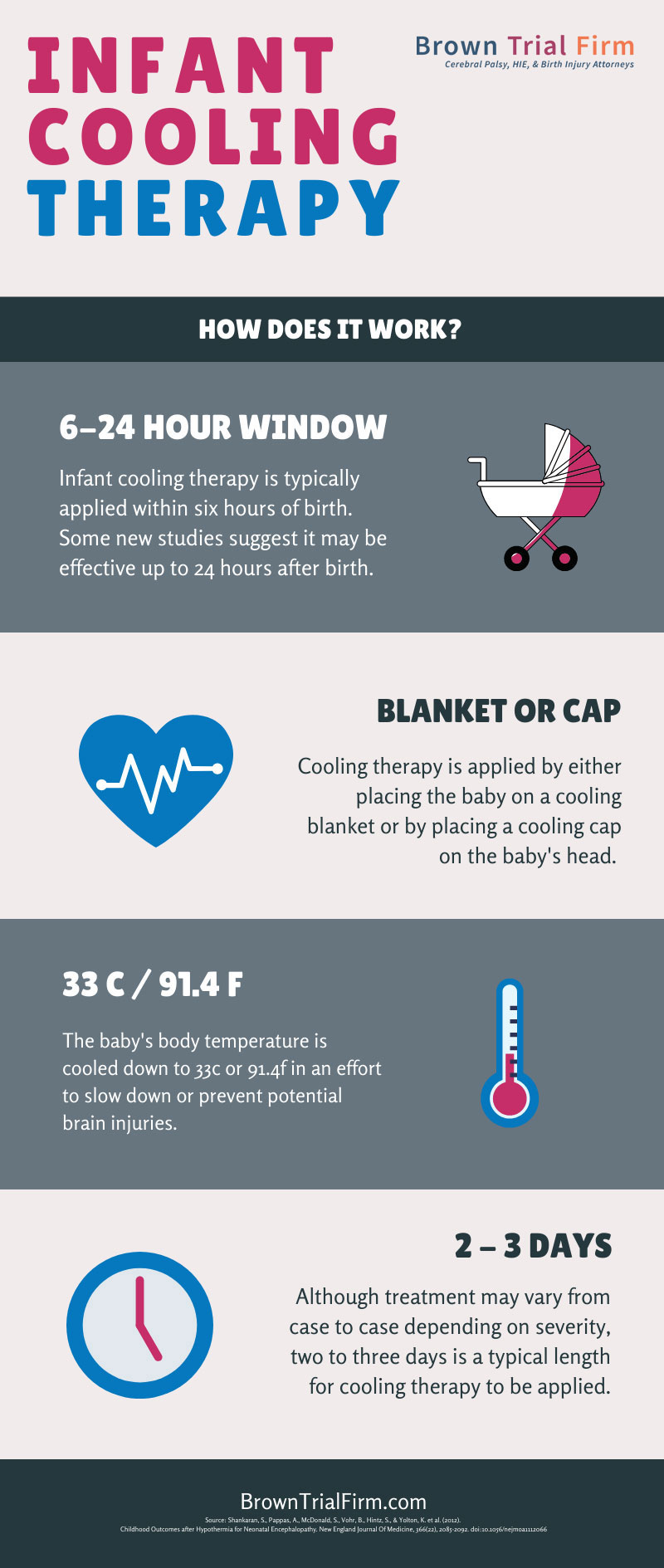Was your newborn injured during therapeutic hypothermia or another HIE treatment?
Talk to a texas birth injury attorney who has dedicated her entire career to recovering financial security for injured newborns & families nationwide
A baby’s first breath is a beautiful thing. Unfortunately, not all births go smoothly. And what happens in the delivery room or the neonatal intensive care unit (NICU) can impact a newborn and their parents for the rest of their lives.
When a baby is deprived of oxygen during labor and delivery, they are at risk of suffering permanent brain damage due to a condition known as “asphyxia” or “hypoxic-ischemic encephalopathy” (HIE). If left untreated, HIE can result in permanent brain damage and cell death, resulting in serious conditions such as cerebral palsy, brachial plexus injuries, nerve damage, seizure disorders, intellectual disabilities, development delays, motor disorders, hearing and vision loss.
Hypothermia therapy can effectively help minimize or freeze the rate of cell death in a newborn’s brain and prevent long-term brain damage; however, the window of time for this treatment is small. If doctors and medical teams fail to recognize the signs of HIE or they begin brain cooling therapy too late, then the damage may already be done.
When a serious birth injury happens because a doctor failed to uphold a certain standard of care—either by failing to diagnose HIE in a timely manner or not delivering the appropriate treatment soon enough—our birth injury attorneys help families hold these medical professionals responsible for their negligence.
“They went above and beyond to give our family a level of closure that was vital for us to move forward...” - Della C.
“They worked their hearts out to get justice for a young child...I have been a lawyer for 20 years, and can honestly say that this law firm could be the best medical malpractice firm in the country.” - Reynaldo Garza III
lawyer
“I will definitely recommend them to any family. Laura is definitely hands down an amazing lawyer.” - Jacklyn C.
Have questions about a birth injury?
Verdicts & Settlements Financial security for Your Child
Birth injury cases are like babies—every one is unique and special. Although these past success stories are no guarantee of success in your case, they can provide you examples of what we’ve been able to accomplish in similar cases. Contact us to determine the value of your potential claim.
HIE Malpractice Lawsuit
The child’s HIE and CP were caused by hypoxia and ischemia when the umbilical cord wrapped around the child’s neck, preventing the child from getting enough oxygen. The medical providers did not identify the warning signs and did not order a timely c-section. The delay caused severe and permanent injuries.
Cerebral Palsy Malpractice Lawsuit
The child suffered HIE and CP injuries when the medical professionals failed to timely order and perform a c-section in response to fetal distress warnings. A contingent (%) fee charged on the successful recovery resulted in a fee of $3,080,000 and litigation expenses and attorney’s fees which were reimbursed by the client out of the gross settlement amount.
Cerebral Palsy Malpractice Lawsuit
The child suffered HIE and CP as a result of uterine rupture, placental abruption, and a delay in performing an emergency c-section. A contingent (%) fee charged on the successful recovery resulted in a fee of $1,441,584 and litigation expenses and attorney’s fees which were reimbursed by the client out of the gross settlement amount.
FAQ Brain cooling therapy for newborns
If your infant has been placed into a cooling therapy session, you may have questions about what is happening and why. Below we have answers and information that can help you learn about what is going on and help you better prepare for the days and weeks ahead.
- What is “cooling” or hypothermia therapy?
- Why is my infant being cooled?
- When should my baby receive hypothermic brain cooling treatment?
- When should a newborn NOT be given hypothermic therapy?
- How does hypothermic brain cooling work?
- How long does infant cooling last?
- Does cooling help HIE, and is it dangerous?
- What are the benefits of infant cooling?
- Where is “cooling” or “hypothermia therapy” provided?
- How is the baby re-warmed after hypothermia therapy?
- What to expect after cooling?
- How can hypothermic brain cooling treatment go wrong?
- What can I do as a parent?
- What should I do if I believe that hospital negligence caused my baby’s injuries?
What is “cooling” or hypothermia therapy?
If your baby suffered oxygen deprivation at birth and is diagnosed with hypoxic-ischemic encephalopathy (HIE), this is a therapy that helps protect the baby’s brain from worsening and permanent injury. Babies who have suffered a lack of oxygen at birth and have birth asphyxia or hypoxic-ischemic encephalopathy may undergo “cooling” therapy or hypothermia therapy. This treatment may also be called “head cooling”, “total body cooling”, “cooling cap”, “cooling blanket”, “neonatal cooling” or “therapeutic hypothermia.”
HIE can destroy brain cells leading to permanent brain damage or sometimes even death. Studies have shown that babies who were oxygen deprived around birth and are treated with therapeutic hypothermia have a better chance of surviving without brain injury.
This controlled therapy can lower the infant’s brain and body temperature, altering the chemical processes of the brain and reducing the infant’s risk of sustaining permanent brain damage.
Why is my infant being cooled?
The infant is likely being cooled because the baby suffered from birth asphyxia, which is a brain injury called hypoxic-ischemic encephalopathy (or HIE).
HIE stands for:
- Hypoxic – Lack of oxygen
- Ischemic – Decreased blood flow
- Encephalopathy – Affecting the brain
HIE is also commonly referred to as oxygen deprivation and it can lead to brain damage.
Many things can cause HIE, including:
- Problems with the uterus. Uteroplacental Insufficiency or uterine rupture
- Problems with the placenta. Placental insufficiency, abruption, previa and preeclampsia
- Problems with the umbilical cord. Umbilical cord compression or prolapse, nuchal cord or umbilical cord knot
- Delay in delivery. Fetal distress, failure to monitor and diagnose heart rate abnormalities, delay in Cesarean section, shoulder dystocia (baby is “stuck” and deprived of oxygen)
- Maternal disorders. Maternal blood clotting disorders, maternal hemorrhage, maternal hypotension (low blood pressure)
- Trauma during delivery. Vacuum extractor injuries, forceps injuries, skull fractures, hemorrhage or bleeding in the baby’s brain
When should my baby receive hypothermic brain cooling treatment?
If your baby suffered hypoxic-ischemic encephalopathy, cooling or hypothermia therapy should be started quickly—ideally within 6 hours of birth, though some research suggests that hypothermic therapy may be effective on newborns up to 12 hours old.
While the exact criteria for when a newborn is given brain cooling treatment can vary from hospital to hospital, the Neonatal Encephalopathy Task Force (a division of the Academic Medical Center Patient Safety Organization, or AMC PSO) has set the following general recommendations.
Eligibility Criteria I
If all 3 of these criteria are met, then therapeutic hypothermia should be given:
- The baby was born after 36 weeks of gestation (pregnancy) and is less than 6 hours old
-
Any 1 of the following conditions are present:
- Sentinel event prior to delivery, such as uterine rupture, profound fetal bradycardia or cord prolapse
- Low Apgar scores (5 or under at 10 minutes of life)
- Prolonged resuscitation at birth (chest compressions, intubation and/or mask ventilation at 10 minutes)
- Severe acidosis (pH less than 7.0 from cord or neonate blood gas within 60 minutes of birth)
- Abnormal base excess less than or equal to 16 mEq/L from cord gas or neonate blood gas within 60 minutes of birth
-
AND 1 of the following is true:
- There is a clinical event indicating a neonatal seizure
- There is evidence of neonatal encephalopathy during a clinical exam
Eligibility Criteria II
The AMC PSO advises doctors to consider hypothermia therapy when the following 3 criteria are met:
- The baby was born after 36 weeks of pregnancy and is no more than 12 hours old
-
Any 1 of the following conditions are present:
- Sentinel event prior to delivery, such as uterine rupture, profound fetal bradycardia or cord prolapse
- Low Apgar scores (5 or under at 10 minutes of life)
- Prolonged resuscitation at birth (chest compressions, intubation and/or mask ventilation at 10 minutes)
- Acidosis (pH less than 7.1 from cord or neonate blood gas within 60 minutes of birth)
- Abnormal base excess less than or equal to 10 mEq/L from cord gas or neonate blood gas within 60 minutes of birth
- Postnatal collapse resulting in hypoxic-ischemic injury (i.e., near-SIDS type event)
-
AND 1 of the following is true:
- There is a clinical event indicating a neonatal seizure
- There is evidence of neonatal encephalopathy during a clinical exam
The sooner this treatment begins, the better the odds that the newborn’s HIE-induced brain injuries will be reduced and a permanent disability can be avoided. Failing to provide hypothermic brain cooling when it’s needed may be considered medical malpractice, in which case a parent can pursue legal compensation.
When should a newborn NOT be given hypothermic therapy?
According to the AMC PSO, babies born preterm under 34 weeks into the pregnancy should absolutely not be given hypothermia treatment. In addition, doctors must take extra care when prescribing this treatment to newborns who:
- Weigh less than 1,750 grams (3.8 pounds)
- Have congenital abnormalities, genetic syndromes or metabolic disorders
- Have overwhelming septicemia
- Suffered major intracranial hemorrhage
- May have a blood clotting disorder
If a newborn is given therapeutic hypothermia treatment when they shouldn’t have (outside of the recommended criteria), then they can suffer additional injuries and the doctor may be liable for medical malpractice.
How does hypothermic brain cooling work?
Many parents wonder how the cooling process works and how therapeutic hypothermia halts the spread and severity of brain damage. The science behind hypothermia therapy is complicated.
Simply put, infant cooling therapy is a process where your infant is cooled and then gradually warmed up again. A specially-made blanket, mattress, or head cap will be used to cool the newborn in a controlled way.
There are 2 different approaches to therapeutic hypothermia:
- Passive cooling techniques involve removing external heat sources from the newborn, such as blankets and heating lamps. This method is commonly used by remote hospitals and facilities with limited infrastructure that may be unable to transport newborns to a hypothermia center for active cooling within 6 hours.
- Active cooling is the preferred method. One study found that “the use of active cooling during neonatal transfer achieves target temperature in a shorter period and maintains better temperature stability.”
While the newborn cooling protocol and processes can vary depending on the hospital, it typically involves placing the baby on a waterproof blanket or putting a cooling cap on their head that contains cool circulating water until the cooling baby’s body temperature is reduced to as low as 33.5 degrees Celsius or about 92.3 degrees Fahrenheit—below homeostasis—for around 72 hours. This reduced body temperature helps slow the newborn’s metabolic rate, which allows their cells to heal and prevents the further spread of brain damage.
When the baby’s body temperature is cooled, it slows the baby’s metabolism or metabolic rate. Metabolism is a set of chemical reactions that happen in all of our cells in which food is converted to fuel to run our cells, organs and bodies. Those chemical reactions require oxygen. If oxygen is removed from the chemical reaction, the reaction still happens but it produces a harmful byproduct—lactic acid—that damages or kills cells.
When there is enough oxygen, the brain cells produce energy in a normal chemical reaction causing aerobic respiration. The chemical reaction produces energy for the cells to function and harmless byproducts. But, when the blood flow and oxygen to the brain is disrupted, the chemical reaction changes to anaerobic respiration which produces lactic acid as a byproduct. Lactic acid build ups and triggers release of several harmful chemicals, including highly reactive free radicals.
Meanwhile, cell walls break down causing swelling or “edema.” As the brain cells die, the cooling baby’s immune system sends neutrophils and macrophages to clean up dead cells, which starts a chain reaction by producing free radicals that further damage cells, deepen the inflammatory response, aggravate cerebral swelling and cause further neurological injury.
When the baby is resuscitated and the blood and oxygen return, this can further damage the cells and tissues that are already weak from the initial injury. The damaged cells are leaky and the newly returned blood flow can make the cerebral edema (the swelling) worse, causing more inflammation and more free radical release. Cooling or therapeutic hypothermia helps shut down this process.
Cooling the newborn is believed to minimize damage to the baby’s brain by:
- Reducing energy depletion
- Reducing the metabolism
- Decreasing excitatory transmitter action in their brain
- Reducing ion flux alterations
- Reducing edema (swelling)
- Reducing vascular permeability
- Reducing blood-brain barrier disruptions
How long does infant cooling last?
The cooling process should always be carefully monitored. The extent and length of cooling therapy that is administered to your infant is in direct correlation to how severe your baby’s injury is thought to be.
A more severe injury will require a longer cooling therapy session. In general, you should expect your infant to be in cooling therapy for 2 to 3 days. Following this time, the infant will be gradually warmed up by a doctor and further assessments will be made of the baby’s condition.
After the treatment, the baby’s core body temperature must be returned to homeostasis (36.5 degrees Celsius, or 97.7 degrees Fahrenheit) gradually and carefully in order to avoid a reperfusion injury, which is when blood flow is restored too quickly to injured parts of the brain and brain damage is worsened. During rewarming, there is a greater risk of seizure, so doctors should closely monitor the newborn—possibly using an EEG.
Does cooling help HIE, and is it dangerous?
There are certainly risks involved when medical staff induce hypothermia in an infant. However, research suggests that when the cooling therapy is properly administered, the potential benefits often outweigh the risks.
Numerous studies have shown that hypothermia therapy can benefit newborns suffering from lack of oxygen at birth:
- A 2005 study supported by the National Institutes of Health and published in the New England Journal of Medicine found that a cooling treatment given to newborns with birth asphyxia reduced the risk of death and disability by ages 18 to 22 months compared to routine care. Researchers discovered that newborns in the hypothermia group had a significantly lower mortality rate (28%) compared to the usual care group (44%).
- In a subsequent study, researchers found that newborns with perinatal asphyxial encephalopathy who received hypothermic therapy showed improved neurocognitive outcomes in middle childhood—such as significant reductions in the risk of cerebral palsy and moderate or severe disability, as well as significantly better motor-function scores.
When administered correctly, researchers have found that there are relatively few risks associated with infant cooling therapy—and that the benefits generally outweigh the potential risks. The most common side effect is sinus bradycardia, or a slowed heartbeat, which is not considered to be life-threatening and can possibly be treated.
Therapeutic hypothermia protects the brain from more damage and more permanent injury because the brain is injured not only when oxygen-supplying blood flow is first disrupted but also when the blood and oxygen return during and after resuscitation—a process called “reperfusion.” The injury that happens after the oxygen is returned is called “reperfusion injury.” Therapeutic hypothermia is a “neuroprotective” therapy because it slows or prevents reperfusion injury.
The most common side effect of cooling therapy is sinus bradycardia, which is a slowed heart rate. This is characterized by a sinus rhythm (heart rate) of 60 beats per minute or fewer.
Sinus bradycardia is not considered life-threatening and—depending on the cause and severity—medical staff will address it appropriately.
What are the benefits of infant cooling?
The immediate positive effect of using cooling therapy is that it will slow down the naturally occurring processes happening in the infant’s brain. In this situation, that’s a good thing because these processes could otherwise lead to permanent brain damage.
Edema, or brain swelling, and brain cell death are the 2 most common results of HIE. Cooling therapy can help prevent both.
Cooling therapy is still a relatively new treatment. When it comes to the long-term benefits, cooling therapy is believed to minimize injury and improve your child’s quality of life for years and years to come.
One study found that more than half of oxygen-deprived babies who were treated with hypothermia (cooling) survived to age 6-7 and had a normal IQ (Intelligence Quotient).
Where is “cooling” or “hypothermia therapy” provided?
Not all hospitals are properly equipped to provide therapeutic hypothermia. If the hospital where the baby was born does not provide hypothermia therapy, the baby may be transferred to a neonatal intensive care unit (“NICU”) that provides cooling therapy. Cooling or therapeutic hypothermia usually must be started within the first hours after birth of the baby, so a baby with HIE should be evaluated for transfer to a facility capable of therapeutic hypothermia shortly after birth.
How is the baby re-warmed after hypothermia therapy?
After the cooling process is complete, the baby must be rewarmed slowly and carefully to prevent the reperfusion injury described above. The baby’s temperature should be increased by 0.2 – 0.5 degrees Celsius, and the baby should be closely watched to check for seizure activity through EEG monitoring.
What to expect after cooling?
The cooling therapy session will last around 2 to 3 days. Following the cooling therapy, the baby will need to be assessed further and continue to be monitored. Monitoring will ensure that your baby is able to eat, digest, and function as a healthy infant.
The medical staff may want to administer multiple tests and monitor various aspects of the baby’s development. They may run MRIs, EEGs, and monitor the baby’s heart rate as standard procedure. This is to ensure that the baby has no abnormal activity in their brain, body, or heart.
The amount of time that the baby will spend in the hospital following cooling therapy will depend on their overall prognosis and health. Most babies who begin to feed and digest their food properly and who have regular bowel movements and urinate correctly can be discharged if no other complications are present.
If doctors suspect a secondary condition or complication of some kind, they should communicate that with the parents and have the baby kept longer in the NICU to ensure that they are healthy and prepared when the parents take the baby home.
How can hypothermic brain cooling treatment go wrong?
Even though neonatal cooling therapy is a widely proven and generally accepted treatment for newborns experiencing HIE, it’s important for medical providers to carefully follow strict procedures and steps to ensure the effectiveness of the therapy and avoid potential negative impacts. Failure to follow these procedures can negate the treatment and cause further injury.
Here are some common examples of how therapeutic hypothermia in babies can go wrong:
- A baby is given hypothermic therapy too late (after 6-12 hours of birth)
- Failure to transfer the infant to an appropriate facility with active hypothermia capabilities
- A baby’s core body temperature is rewarmed too quickly, resulting in a reperfusion injury
- A newborn who doesn’t meet the eligibility criteria (i.e. is pre-term, has an APGAR score above 5, etc.) is given cooling therapy
- Cooling measures are not reduced or stopped when the baby’s rectal temperature falls below 95 degrees Fahrenheit
- The rectal thermometer isn’t properly inserted, thus resulting in incorrect readings of the baby’s temperature
- Failure to manage acidosis (acid in blood)
- A baby exhibiting signs of stress is not given sedation, since stress has been shown to negate the effects of hypothermia therapy
- Sodium and chloride levels are not monitored and fall below normal levels
- The medical team fails to maintain normal glucose and electrolyte levels
- Oxygen saturation levels aren’t properly monitored, as cooled infants are at risk of persistent pulmonary hypertension
- Doctor fails to provide respiratory and cardiovascular support as needed
- Insufficient testing for and treating of infections
What can I do as a parent?
Waiting for your infant to be cooled and monitored can feel as though it’s taking forever, but waiting and being patient are the most important things to remember. In the meantime, educating yourself so that you can understand what your infant is going through is a great step.
If you have questions, don’t be afraid to ask for help, and take plenty of notes so that you can refer back to what has happened later.
What should I do if I believe that hospital negligence caused my baby’s injuries?
Although there are many different causes of birth injuries, one of the most dangerous and preventable causes is negligent healthcare. When mistakes are made during the labor and delivery process, those mistakes expose the baby to risks like HIE.
If you think your child may have suffered from lack of oxygen, or if your newborn child has been diagnosed with HIE, then your child may be a victim of a birth injury that was preventable. To learn and best protect your baby, it’s important to act quickly and get help now.
Sources
Therapeutic Hypothermia for Neonatal Encephalopathy: https://www.ncbi.nlm.nih.gov/pmc/articles/PMC3519960/
Hypothermia for newborns with hypoxic ischemic encephalopathy: https://www.ncbi.nlm.nih.gov/pmc/articles/PMC3276531/
Hypothermia and Neonatal Encephalopathy: https://pediatrics.aappublications.org/content/133/6/1146
Clinical features, diagnosis, and treatment of neonatal encephalopathy: https://www.uptodate.com/contents/clinical-features-diagnosis-and-treatment-of-neonatal-encephalopathy
ICU Clinical Pathway for Therapeutic Hypothermia Treatment for Neonates with Hypoxic Ischemic Encephalopathy (HIE): https://pathways.chop.edu/clinical-pathway/therapeutic-hypothermia-hypoxic-ischemic-encephalopathy-hie-clinical-pathway
https://cookchildrens.org/neonatology/specialty-programs/Pages/Therapeutic-Hypothermia.aspx
https://www.texaschildrens.org/departments/neonatology/body-cooling-treatment
https://www.archildrens.org/programs-and-services/neonatal-intensive-care-unit?journey=symptoms
https://www.rmf.harvard.edu/Clinician-Resources/FAQ-Category/AMC-PSO
Therapeutic hypothermia after cardiac arrest: https://www.myamericannurse.com/therapeutic-hypothermia-after-cardiac-arrest-what-why-who-and-how/.
Many of the causes of HIE are entirely preventable with careful monitoring and quick treatment. It’s a sad reality that medical mistakes and doctor negligence are common causes of HIE.
Talk to an HIE attorney about your legal rights
Hypothermic brain cooling is a promising treatment option for newborns suffering from moderate to severe HIE. However, it’s vital that doctors, physicians, nurses and other medical staff strictly adhere to the guidelines and recommendations set by experts as the standard of care. Failing to administer cooling therapy in a timely manner or failing to inform parents about this treatment option, may constitute medical malpractice.
Laura Brown is a nationally respected and recognized birth injury lawyer who has devoted her career to representing injured babies and their families. She founded the Brown Trial Firm, a Texas-based law firm, to exclusively serve clients in Texas, Oklahoma and across the country. She has obtained many multi-million dollar settlements as a result of birth injury lawsuits and medical malpractice lawsuits.
- Cerebral Palsy
- Caput Succedaneum and Cephalohematoma
- Neonatal Intracranial Hemorrhage (Childbirth Brain Bleeds)
- Hydrocephalus (Extra Fluid in the Brain Cavity)
- Cervical Dystonia
- Hemiplegia (Brain or Spinal Cord Injury)
- Hemorrhagic Stroke
- Neonatal Stroke
- HIE
- Periventricular Leukomalacia (PVL) Brain Injury
- Infant Seizures
- Spastic Diplegia (Spasticity in the Legs)
- Top Risks for Birth Injuries
- Fetal Alcohol Syndrome
- Facial Paralysis
- Spinal Cord Injuries
- Bell’s Palsy
- Brachial Plexus Nerves & Erb’s Palsy
- Klumpke’s Palsy
- G-Tubes for Newborns
- Medical Errors
- Cesarean Section & Birth Injury
- Negligence in Brain Cooling Treatment
- Craniosacral Therapy
- Occupational Therapy
- Speech Therapy
- Transition From Pediatric to Adult Healthcare
- Surgical Options for Spastic Cerebral Palsy
- Fetal Intolerance to Labor
- Jaundice (Kernicterus)
- Breech Position
- Placental Complications
- Umbilical Cord Problems
- Uterine Rupture
- Cervical Incompetence (Insufficiency)
- Blighted Ovum
- Necrotizing Enterocolitis (NEC) - Intestinal Inflammation
- Cephalopelvic Disproportion
- Meconium Aspiration Syndrome
- Amniotic Fluid Embolism
- Birth Injury from Premature Delivery
- Developmental Delays
- Abnormal Cord Insertion
- Infections at Birth
- Chorioamnionitis Bacterial Infection
- Premature birth
- Oxygen Deprivation
- Listeria
- Birth-Acquired Herpes
- Placenta Previa
- Placental Abruption
- Mismanaged Fetal Malposition
- Rapid Labor
- Obesity Related Birth Injuries
- Intrauterine Growth Restriction
- Blood Clots During Pregnancy
- Ectopic Pregnancy Misdiagnosis
- Myths & Facts About Birth Injuries
- Bacterial Vaginosis
- Gestational Diabetes
- Maternal Mortality Risk
- Oligohydramnios (Low Amniotic Fluid)
- Infections During Pregnancy
- Excessive Bleeding During Pregnancy
- Congenital Syphilis




